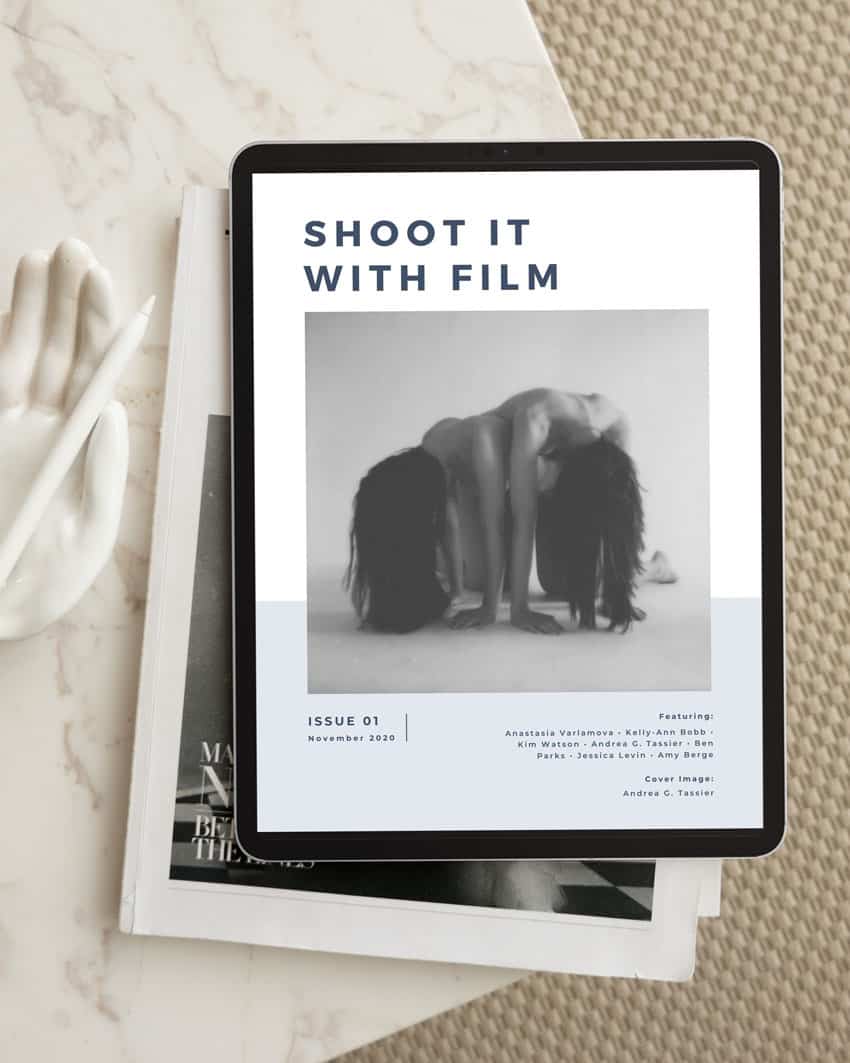
Written by Taylor Blanchard
Whether you’re a new or seasoned film photographer, when you think of color film, the names Kodak or Fuji most likely come to mind. These two behemoths have long histories with color film, and I recall a time when you would ask someone, “Fuji or Kodak?” – akin to asking someone, “Coke or Pepsi?”
Manufacturing color film is a complex process, and there are very few companies left in the world that still make color film.
This year, Fuji announced it’s no longer making Superia Xtra 400, which answered a question many people had pondered in recent years, namely, “Is Fuji still making film?” It leaves a huge gap in the color film manufacturing market.
Other well-known companies, like Germany’s Agfa, stopped manufacturing film decades ago. For a few years, Ferrania made Agfa, and then Fuji. Ferrania’s kickstarter about 10 years ago promised to start making color film again, and while it’s exciting to see their black and white films, it may be some time before we see a color film from them.
Adox has also been working on a new color film, yet production has been challenging, and it’s uncertain when it will be released.


The State of Color Film Today
Very simply, there are several ways that color films come to market today.
- A company like Kodak manufactures emulsions. As I noted, there are very few companies that have the capability to manufacture film given the expense and complexity.
- Some brands, like Lomography, contract with a manufacturer to make their own formulations of film.
- Many brands repackage or modify existing films. It’s not a new film per se, but an existing film that is different in some way.
There are two primary repackaged color films that you can find today:
Cinema Film:
One of the best-known examples of a modified cinema film is the CineStill 800T, which uses Kodak’s Vision 500T motion picture film for still photography.
Motion picture films have a ‘remjet’ layer that protects the film from light piping (light leaking into the film) and halation (when highlights bleed into the image – often seen as a reddish glow on points of light). By removing this layer, the film can be developed in the C-41 process.
Otherwise, if the remjet layer is still part of the film, you develop it with the ECN-2 process, or remove the remjet layer yourself to develop in C-41.
Aerial Film:
Another repackaged film is Kodak Aerocolor IV, an aerial surveillance film, which is still used today for mapping and reconnaissance. It’s not to be confused with the much-missed Aerochrome Color IR film.



Testing 7 Lesser-Known Color Film Stocks
We’ve seen a flood of new films in the past few years. Some of the brands are open about the origin of their films, and others are more cryptic.
A known film hoarder, I’m often first in line to buy a new film when it hits the market. For this article, I shot many lesser-known color films. I tried to put each film through its paces, shooting each under varying lighting conditions. It wasn’t a perfect experiment: I used three different cameras, so the optics could affect the individual results, but I took enough photos to get a general sense of the film’s performance.
The Results
Flic Film Elektra 100
| # of Exposures | 36 |
| Origin | Kodak Aerocolor IV |
| ISO | 100 |
| Color | True, saturated, greens emphasized |
| Contrast | Moderate |
| Exposure Latitude | Wide |
| Grain | Fine |
| Halation | None |
| Overall Rating | 4 out of 5 |
Flic Film is a Canadian company that makes a wide range of films, chemistry, and darkroom paper. Flic Film uses Kodak Aerocolor IV for Elektra 100 and are transparent about the origins of the film.
I love the way the film renders color and the film overall performed well in several lighting situations. Color rendition was very accurate, except in underexposure situations, where it tends to be a bit green.
One note: Aerocolor is known for light piping, so you must load this film in subdued light.
Read a more detailed review of Flic Film Elektra 100 here.
Find Flic Film Elektra 100 at B&H Photo.



Related: Guide To Choosing A Color Film
CatLABS X-Film 100 Color
| # of Exposures | 36 (also available in 120) |
| Origin | Kodak Aerocolor IV (most likely) |
| ISO | 100 |
| Color | True, warm |
| Contrast | Moderate plus |
| Exposure Latitude | Wide |
| Grain | Very smooth in 120 |
| Halation | None |
| Overall Rating | 4 out of 5 |
I loved the warm colors and fine grain of CatLABS Color 100 film, and especially love that it’s available in 120. Because I shot it in 120, grain was almost not evident.
CatLABS makes the only 120 film that I tested, which they also sell in 35mm. CatLABS Color 100 is likely Aerocolor, and while they mostly acknowledge the films’ origin, they claim they’ve made some modifications.
I loaded it in the shade outdoors, which gave me some light leaks and leads me to believe it’s Aerocolor.
Find CatLABS X-Film 100 Color at B&H Photo.




Harmon Phoenix 200
| # of Exposures | 36 |
| Origin | Created from scratch |
| ISO | 200 |
| Color | Varied depending on lighting, tends to blues and greens |
| Contrast | Moderate to high |
| Exposure Latitude | Narrow |
| Grain | Evident |
| Halation | Yes |
| Overall Rating | 3 out of 5, will shoot again |
Harmon, the parent company of Ilford, made a big splash by releasing one of the first brand new color emulsions to be developed from scratch. The news and results were discussed widely on social media, and the company was very transparent about the challenges in manufacturing a new color film.
They’re committed to continuing to make color film and ask users of the film for feedback, so they can tweak the next version.
This was certainly the strangest film I shot – the results were quite varied. I found it didn’t handle bright scenes well, yet other reviews of the film say the best results were in bright outdoor scenes. The shadows are very interesting and veer towards blue.
I’m going to shoot this film again and support Harmon’s efforts with the hopes the next version will be improved.
Find Harmon Phoenix 200 film at B&H Photo.




Related: LomoChrome Metropolis Film Review
ORWO Wolfen 400
| # of Exposures | 36 |
| Origin | German cinema film |
| ISO | 400 |
| Color | True with a green cast |
| Contrast | Moderate plus |
| Exposure Latitude | Forgiving |
| Grain | Noticeable but smooth |
| Halation | None |
| Overall Rating | 5 out of 5 |
A German motion picture film manufacturer, ORWO released its first new films in decades with the Wolfen 400 and 500NC. The film is made at a facility that has been manufacturing film since 1910. ORWO says these films are based on an Agfa cinema film formulation.
The film has a bit of a green cast, especially in lower light, and the color is unique; However, I really enjoyed this film. It’s different enough to stand out, but not so different that it looks experimental.
What surprised me most is that even though it’s based on a cinema film, there is no halation. Knowing the results, I’m excited to shoot this film again.
Find ORWO Wolfen 400 film on Amazon or at B&H Photo.





KONO! Color 400
| # of Exposures | 36 |
| Origin | German color negative, cinema? |
| ISO | 400 |
| Color | Muted |
| Contrast | Moderate |
| Exposure Latitude | Forgiving |
| Grain | Fine |
| Halation | Noticeable but smooth |
| Overall Rating | 4.5 out of 5 |
KONO launched in 2014, and their first products were modified cinema film with the remjet layer removed.
With a history in analogue film (they also say they were involved in the R&D for LomoChrome Purple and have a partnership with Svema, the Ukrainian film maker), KONO has a dizzying array of products from a kickstarter for packfilm, that is now One Instant, to many low ISO and experimental films.
It’s unclear the origins of the KONO! Color 400, and the company doesn’t provide a datasheet. They only note that the results are muted at 400 ISO, and you can get more saturated colors by rating the film at 200 ISO.
While the grain is pronounced, I love the overall look of the film; However, it’s one of the more expensive films I shot.
Find KONO! Color 400 film at B&H Photo.




Panther City 400
| # of Exposures | 36 |
| Origin | Kodak Vision3 250D cinema |
| ISO | 400 |
| Color | Vibrant |
| Contrast | Deep |
| Exposure Latitude | Wide |
| Grain | Evident but pleasing |
| Halation | Yes |
| Overall Rating | 4 out of 5 |
The company is open about the origins of their cinema films and proclaims a love for keeping film alive. Otherwise, there’s not as much information about Panther City 400 film, and it might be the least well-known of the films I shot.
I was surprised by the colors and thought this film performed well on shaded days. After shooting similar films, such as CineStill 400D, I thought this film performed well with possibly more even results in different lighting.
Find Panther City 400 film at panthercityfilm.com.




Candido 800
| # of Exposures | 24 |
| Origin | Cinema film |
| ISO | 400 |
| Color | Vibrant |
| Contrast | Moderate |
| Exposure Latitude | Wide |
| Grain | Pronounced |
| Halation | Yes |
| Overall Rating | 4 out of 5 |
Candido Collective is a company based in the U.K. that makes films in ISOs of 200, 400, and 800 balanced for both daylight and tungsten. They also sell a simple camera and bag.
Their website notes that they work with partners “across Europe and Asia,” which leaves a lot of speculation about which of their films are which.
As you would expect with an 800 speed film, it has noticeable grain. It also gives moderate contrast and saturation.
There are a surprising number of 800 speed films balanced for tungsten given availability of cinema films, and Candido is a strong choice among the competition. Some may wish for more exposures; I often enjoy 24 exposures when 36 can feel like a lot to shoot.
Find Candido 800 film at candidocollective.com.





Conclusion
After years of films being discontinued, it’s exciting to see more films come to the market. Using the soda analogy, we have more choices when we’re thirsty.
These new color films – even the ones with a shared cinema or aerial film lineage – are generally unique and have very different characteristics than you would find in other products.
Availability of these color films can be inconsistent, and, given their unique look and different film bases, scanning and editing can be more challenging.
My two favorites were the Orwo Wolfen 400 and the KONO! Color 400 – mostly because they gave me more distinct looks than I could get in other films.
Have you tried any of these films or are you interested in trying any of these? Or do you stick with a favorite color film? Let me know in the comments.

Thank you so much, Taylor! Taylor is a regular contributor here at Shoot It With Film, and you can check out her other articles here, such as Set It & Forget It Film Developing: An Introduction to Stand Development and Pulling Film: Misunderstood, Overlooked, or Worth Forgetting?.
You can also check out more of Taylor’s work on Instagram.
Leave your questions about these lesser-known color film stocks below in the comments!








Blog Comments
etienne dezutter
May 31, 2024 at 10:53 am
hi Taylor nice you did the test shoot for us … I worked also with Flickfilm .Your Colors were vibrant mine were tending to red ..I thought this was may”be aviationfilm ? Did you use filtering with Flckfilm?v The candidio is also available here.dIDN4T TRY IT ; What I bought was Cazzo a film with remjet for developing in ECN. I see what is will give .Normal I buy Silbersalz in Germany (with remjet also , cinefilm who is very good).I’m intending to buy some b and w Spur UFG(new) iso 50 .IGood rates from users! Nice day!
Taylor Blanchard
May 31, 2024 at 12:58 pm
Hi Tjen! So glad to see your comment here. I didn’t use any filters with the Flic film. Maybe try overexposing the film by 1 stop next time you try it? My guess is it can tend to red in underexposure situations, like Ektar? I’m jealous you shoot Silbersalz – I can never find it in the U.S.
Frank Wolff
May 31, 2024 at 12:37 pm
Great film testing article. Thanks for putting in the effort.
Phoenix 200
My experience was Meh. Over saturated towards orange and grainy. The highlights blew out quickly and shadows became muddy with slight underexposure. Maybe if your lighting is perfect it’ll be ok, but it’s not cheap for an experimental film. I’m going to pass.
Thanks again
FW
Taylor Blanchard
June 1, 2024 at 5:16 am
Hi Frank – thank you for the comment! Agree that Phoenix is a bit strange and can lead towards ‘meh.’ I wanted to include it to drive home that point that is very difficult to manufacture color film, and very few companies do it any longer. I know Harmon is listening to feedback so I hope their Phoenix 2.0 is improved.
Frank Wolff
June 2, 2024 at 12:00 pm
Do you have any experience with Rollie’s Paul & Reinhold 640 B&W film? I would like to try it. Rollie suggests using their Supergrain developer. Any opinion on the film or developer? I typically use DDX. Thank you, FW
Taylor Blanchard
June 3, 2024 at 9:52 am
Frank – I haven’t shot that Rollei film – I will have to try it out. Massive Dev has development times for Paul & Reinhold 640 B&W using DDX. Ilford DDX is a great developer!
Alastair Place
May 31, 2024 at 1:29 pm
Fabulous images and a fascinating article Taylor! I’m not sure I should have read this article as I am now looking for several of the films!!
Taylor Blanchard
June 1, 2024 at 5:20 am
Hi Alastair – I’m thinking I’ll have to shoot one of these for our next transcontinental blind double film swap … 🙂
Walt
May 31, 2024 at 7:19 pm
Taylor – What a great review! I enjoy the CatLab X Film 100 in color as well as their X Film 320 in b/w. Super fine grain on each of them.
And nice to meet you on zoom today with AmyLiz
Taylor Blanchard
June 1, 2024 at 5:19 am
Hi Walt – I’m so glad we got the chance to chat – I love your work.
Thank you for the comment – I also love CatLABS film and the price point is great. I started shooting their B&W 80 ISO when I was learning on my 4×5 because it’s a great stock and so much more affordable than other 4×5 films.
Take care and looking forward to chatting again!
eddy
May 31, 2024 at 9:10 pm
Hello. I just read your article. I know of these films except for Panther city. Are they based in the US? I did not see much on their website. I did like the colors of it. I hope to use phoenix as well. I see it has an orange saturation. The reason I use film for the unpredictability. I think Reformed film lab in Florida carries Candido but not 100 percent sure. I love Ektar. It is my favorite. I love saturated film and sad Fuji Xtra superia is discoed. That was another saturated film. Now Fuji is made in The US. Rumor it is made by Kodak. I will go back to using Kodak Ultramax as well. Cat labs is a film I wanted to try for a while and the New Cinestill. Try Lomo 800 . It is pricey but used it a few years ago on a model photoshoot. I used a reflector . It came out nice. Many have said they prefer Lomo 800 over Portra 800. I just love film so I use many types in many types of cameras. It is all I use.
Taylor Blanchard
June 3, 2024 at 9:49 am
Eddy – me too – I love film so much and it’s all I shoot. I bought the Panther City film at the now-defunct Marfa Film Shop in Texas. Legacy Photo Lab in Dallas carries it; I wonder if the company is Texas-based? I’ll let you know if I hear anything else about it.
Most people agree that Kodak is making film for Fuji now – at least the 200 and 400 color.
I have some Film Washi that I need to shoot!
eddy
May 31, 2024 at 9:15 pm
Film WashI is another film I want to use. It is hand made in France. Freestyle photo carries it. It gives very unique results.